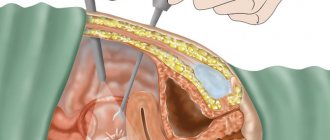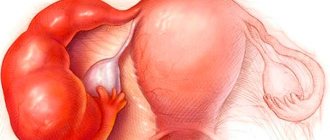Duphaston is not the drug of choice for endometriosis. The use of the drug in women with the disease who are planning a pregnancy or are already carrying a baby is of great importance. Schemes and doses of medication vary significantly depending on the clinical picture - from 10 mg/day to 80 mg and sometimes more. The course of treatment is from 2-3 to 6-12 months.
For the treatment and prevention of endometriosis, preference should be given to drugs based on dienogest, for example, Visanne. The medicine has a large evidence base on safety and effectiveness, which is confirmed by numerous reviews from doctors and women.
Duphaston
Endometriosis is a common disease in women of childbearing age and is characterized by the growth of tissue similar to the endometrium (the inner lining of the uterus) beyond the lining of the uterus. This disease can cause infertility. It is for the treatment of such a disease that the drug Duphaston .
It is especially effective for non-advanced forms of endometriosis, as it is a gentle medicine. In severe forms, surgery may be necessary. Duphaston is a hormonal drug (an artificial analogue of progesterone ), which helps to replenish its deficiency in a woman’s body and stimulate the regular rejection of endometrial tissue. The most important thing is that this medicine improves hormonal levels in the body and actively fights endometriosis, and does not affect the ovulation process and the ability to conceive a child.
It is very difficult to determine the amount of progesterone in the body, even in a laboratory, and therefore Duphaston is most often prescribed in the following cases: the likelihood of miscarriage, bleeding in early pregnancy, pregnancy disorders, endometriosis and dyshormonal uterine bleeding, treatment of infertility due to hormonal imbalance, disruption of the menstrual cycle, relief of menstrual pain and relief from premenstrual syndrome.
Is it possible to do without hormonal therapy?
Dydrogesterone is used in complex therapy of endometriosis. In addition to hormones, non-steroidal anti-inflammatory drugs, herbal decoctions, vitamins, and probiotics are prescribed. But all these remedies do not affect the cause of the disease and are not able to suppress the growth of lesions. Only hormonal therapy copes with the following tasks:
- Inhibits further progression of the disease;
- Reduces the size of already formed lesions;
- Reduces the amount of monthly blood loss;
- Prevents the development of complications;
- Restores reproductive function - allows you to conceive, bear and give birth to a child.
Hormonal therapy for endometriosis is intended, among other things, to prepare the female body for a successful pregnancy.
You cannot do without hormonal drugs in the treatment of endometriosis, but Duphaston is not the only remedy. In some cases, the use of other medications is justified - COCs, gonadotropin-releasing hormone agonists, etc. These drugs are not prescribed simultaneously. Treatment is carried out with only one selected drug. If the prescribed therapy is ineffective or the disease relapses, the tactics change.
Duphaston operating principle
The essence of the action of this drug during pregnancy is to normalize the level of progesterone in a woman’s blood . If, for any reason, the corpus luteum produces insufficient amounts of the hormone during pregnancy, the pregnancy may end or worsen due to possible bleeding.
With endometriosis, blood normally leaves the uterus through the genital tract, but in a closed space, endometriotic formations easily increase, creating painful sensations . By medicinally increasing the level of progesterone or similar substances, strong growth of uterine tissue (endometrium) does not occur and the unpleasant sensations disappear.
In cases of disorganization of the menstrual cycle, Duphaston are prescribed if there is a deficiency in progesterone production and the 2nd phase of the cycle is shortened.
Duphaston is also for dysmenorrhea (pain during menstruation) - progesterone in high concentrations has a relaxing effect on the uterus and unpleasant sensations disappear.
Recommendation for use:
- Luteal deficiency causing infertility
- Possibility of miscarriage due to lack of progesterone
- Premenstrual syndrome
- Menstrual irregularities
- Repeated amenorrhea (used in conjunction with estrogens)
- Dysfunctions of the uterine system
How to take Duphaston for endometriosis:
- Consult a specialist
- Read the instructions for the drug
- Take the medicine in accordance with your doctor's instructions (this depends on the form and severity of the disease).
- In most cases, Duphaston is taken 10 mg 3 times a day for six months. The maximum period is 9 months. The medicine is taken strictly from the 5th to the 25th day of the menstrual cycle.
Contraindications for the use of Duphaston:
- Breastfeeding
- Individual intolerance to components
- Pregnancy, starting from the second trimester
- Not compatible with some medications (consult a specialist)
Side effects when using Duphaston:
- Possible headaches and migraines
- The appearance of blood clots in the veins
- Pain in the mammary glands
- Uterine bleeding
- Liver disorders
- Swelling in the legs
- Allergic reaction
Side effects of hormone therapy
In clinical studies, the following side effects of dydrogesterone were most often detected in patients:
- Acyclic bleeding from the genital tract and breakthrough uterine bleeding;
- Migraine-type headache;
One of the side effects of taking Duphaston can be a headache.
- Nausea and discomfort in the epigastric region;
- Increased sensitivity and soreness of the mammary glands.
During observation of women taking Duphaston, the following side effects were also identified:
- Hypersensitivity reactions to the drug;
- Hemolytic anemia;
- Deterioration of mood, depression;
- Attacks of dizziness and drowsiness;
- Impaired liver function with the appearance of jaundice and abdominal pain;
- Decreased libido;
- Swelling of the lower extremities and face;
- Weight gain.
It is important to know
If any unwanted side effects develop, you should consult a doctor as soon as possible!
Reviews from doctors.
To verify the effectiveness of the drug, just go to a women’s forum on the Internet and read reviews from real people (a fair majority of them are positive). It is also worth paying attention to the recommendations of doctors, because it is not without reason that doctors consider Duphaston the number one drug when prescribing the treatment of mild endometriosis. The drug has been on the global pharmaceutical market for more than forty years and has been approved by the Ministry of Health of most countries. The cost of the drug at the time of writing is 664 rubles.
Gynecologists speak positively about this drug and often prescribe it . In general, reviews from doctors are very, very good and recommendable regarding Duphaston, but there are people, especially on the Internet, who write negative reviews. As a rule, the reasons for such a reaction are:
- Lack of preliminary examination and identification of the true causes of the disease
- The instructions for use were not studied before starting use
- The drug was not prescribed by a doctor, but was purchased solely based on a description taken from the Internet
Any drug can have both benefits and harm, especially when it comes to such subtle things as hormonal balance. Therefore, before you go to the pharmacy for Duphaston, contact your gynecologist and get the necessary information from him.
Side effects
Discontinuation of Duphaston is required if the following pronounced negative effects on the body occur:
- intense pain in the mammary glands;
- dizziness;
- uterine bleeding;
- itching, urticaria;
- Quincke's edema.
The last three side effects when taking pills develop extremely rarely, but a woman should monitor the body’s reaction and seek help if negative consequences occur.
Consult your physician before use
Taking duphaston for endometriosis
Duphaston for endometriosis is prescribed for mild forms of this disease. Mainly in cases where this particular pathology is the cause of infertility. However, prescribing this particular drug is not always the best choice. In some cases, surgical treatment is not possible. And the choice of treatment depends on many factors, starting with what form of endometriosis and symptoms, and ending with the woman’s desire to soon become a mother (if any).
Symptoms and description of the disease
Endometriosis of the uterus is the spread of endometrial cells (its inner layer) to other organs. Quite often, this disease affects the organs closest to the uterus - the fallopian tubes and ovaries, where endometrial cells are thrown during menstruation. An endometrioid cyst may form in the ovary. In this case, taking duphaston for endometriosis is useless; surgical intervention is necessary. The cyst is removed laparoscopically, and then drug treatment can be carried out. In addition, coagulation of endometrioid lesions can be performed laparoscopically (for advanced stages of endometriosis). In rare cases, the endometrium can grow in distant organs. For example, on the mucous membrane of the nose or eyes. In this case, a woman may experience bleeding from the eyes and nose during menstruation.
Other symptoms of endometriosis are familiar to many women and may have another cause.
1. Pain before the onset of menstruation. Treatment of endometriosis with duphaston in this case can bring significant relief.
2. Increase in the size of the uterus. This may be noticed by a doctor during a gynecological examination.
5. Pain during sexual intercourse.
7. Heavy menstruation.
In addition, endometriosis can be called a companion to uterine fibroids, since both diseases are caused by hormonal reasons - increased levels of estrogen. During menopause, fibroids stop growing, decrease in size, and endometriosis disappears. That is, many women with uterine fibroids will probably also have endometriosis.
The diagnosis of endometriosis (its form, degree of prevalence) can be made by a doctor based on the results of a two-manual gynecological examination, ultrasound examination, as well as histological examination.
Treatment of endometriosis
Today, there are many drugs to treat this disease. The most powerful and effective of them are those that “turn off” the ovaries, that is, artificially introduce the body into a state of menopause. In most cases, the process is reversible, that is, the hormonal levels are completely restored after the end of treatment, menstruation appears again, and the woman can become pregnant. Irreversible menopause can occur if women over 40-45 years of age are introduced into it.
Women who are not prepared for such irreversible consequences and want to have children in the future can ask their doctor how to take duphaston for endometriosis - this drug is milder. Its action is aimed at increasing progesterone levels in the second phase of the menstrual cycle, balancing the levels of estrogen and progesterone.
Duphaston for endometriosis receives mostly good reviews. But this drug can also cause some harm. In the event that the prescription regimen is incorrect and the woman is planning a pregnancy. Before drinking duphaston for endometriosis while simultaneously planning a pregnancy, you need to find out on what day of the cycle ovulation usually occurs. For example, with a 28-day menstrual cycle, this is day 12-14. This is important to do because it is necessary to start taking the drug after ovulation, otherwise implantation of the fertilized egg may not occur. It is necessary to take into account that physiologically, the increase in progesterone, along with all the ensuing consequences, occurs precisely after ovulation. You can find out when ovulation occurred by carefully monitoring subjective sensations (the volume of vaginal discharge may increase, the stomach may hurt a little, libido may increase), by undergoing folliculometry (ultrasound diagnostics) or using special tests at home. The dosage of duphaston for endometriosis is 10 mg 2-3 times a day. On which days of the cycle to take it, you need to find out from your doctor.
In addition to duphaston, oral contraceptives (without breaks) and a hormonal IUD can be used in the treatment of this disease.
Treatment of acute endometritis
Treatment of patients with acute endometritis, as well as exacerbation of chronic endometritis, is carried out in a hospital setting. Therapy is prescribed and monitored by a gynecologist.
Firstly, treatment with antibiotics intravenously or intramuscularly (depending on the severity of the disease) is prescribed for endometritis. Antibiotic therapy is selected taking into account the diagnosed causative agent of endometritis.
Preference is usually given to cephalosporins (ceftriaxone, kefzol, cefotaxime), as well as fluoroquinolones (clindamycin, ciprofloxacin). Treatment of endometritis with duphaston is often prescribed.
It is also often practiced to prescribe a combination of antibiotics from different groups. In addition, metronidazole must be prescribed intravenously or in tablets; this drug suppresses the anaerobic flora.
In addition, against the background of antibiotics, in order to prevent intestinal dysbiosis and candidiasis, antifungal drugs (clotrimazole, pimafucin, and also Diflucan) are used.
For the purpose of detoxification and lowering the temperature, infusion therapy is prescribed (intravenous saline and/or glucose solution).
Additionally, non-steroidal anti-inflammatory drugs (diclofenac, indomethacin in suppositories and tablets) are used, which have an anti-inflammatory and analgesic effect. Taking multivitamins is indicated, as well as correcting immunity with the help of immunomodulatory drugs (thymalin, tactivin). The course of treatment lasts from 7 to 10 days.
Duphaston: a cure for endometriosis, a method of combating infertility and a contraceptive in one set
Duphaston is often prescribed by doctors for endometriosis. This is a hormonal drug that eliminates the cause of the disease and its consequences, one of which is infertility. The drug is prescribed both for endometriosis, when the cells of the inner layer of the uterus spread and grow beyond its boundaries, and for endometrial hyperplasia, in which the pathology is localized in the organ itself.
Treatment with Duphaston allows many women to bring their long-awaited pregnancy closer. After all, this drug normalizes the production of progesterone, which regulates the processes of fertilization, attachment of the fertilized egg to the walls of the uterus and its development. Hormone deficiency prevents pregnancy. It can also provoke endometriosis. But before treating the disease, it is necessary to take into account important nuances. After all, Duphaston can both promote conception and act as a contraceptive. It all depends on the specifics of its application.
Causes of the disease
The cause of endometritis is pathogenic microorganisms, and these are not only bacteria, but also viruses, fungi and protozoa:
- staphylococci;
- streptococci;
- Proteus;
- gonococci;
- coli;
- Klebsiella;
- mycoplasma and chlamydia;
- yeast-like fungi;
- Mycobacterium tuberculosis;
- Trichomonas and others.
An infection that causes inflammation of the uterine mucosa appears in it due to mechanical damage to the endometrium, as well as a decrease in the woman’s body’s defenses. Predisposing factors include:
- complicated childbirth (weakness of pushing, weak labor, bleeding in the afterbirth period, long anhydrous interval - more than 12 hours, caesarean section);
- intrauterine manipulations (installation of an intrauterine device, uterine probing, abortion, diagnostic curettage, miscarriages, metrosalpingography, and hysteroscopy);
- incorrectly performed douching procedure;
- failure to comply with personal hygiene rules, as well as sexual intercourse during menstruation;
- after an abortion, the remains of the fertilized egg, or after childbirth, the remains of the placenta.
The chronic form of endometritis appears due to an inadequately treated or untreated acute form of the disease.
Taking Duphaston when planning pregnancy
Many women, after deciding to become a mother, undergo a comprehensive examination, which may reveal endometriosis, which is often asymptomatic in the early stages. The disease can prevent pregnancy and even lead to infertility. Therefore, it is mandatory for everyone planning to treat it.
It is extremely important to know how to take Duphaston if you have endometriosis if you want to become a mother as quickly as possible. For those planning a pregnancy, there is a special scheme that helps to establish the most favorable hormonal levels for conception and normalizes the level of progesterone in the blood. And if the reason for the failure of fertilization is precisely its deficiency, then the drug will be effective.
According to the instructions for the use of Duphaston for endometriosis by planning mothers, the first dose of the drug should take place on the day of ovulation. To determine this moment with maximum accuracy, you can do a special test or ultrasound of the ovaries. You shouldn’t rely on your own calculations, because it’s easy to make mistakes this way - everyone’s cycle is different, and it can go wrong.
With a standard interval between menstruation of 28 days, ovulation occurs approximately on the 15th day from the first day of the previous menstruation. That is, taking the drug should start from the third week of the cycle. The usual dose is two tablets per day, twice a day. There should be exactly 12 hours between doses.
The answer to the question of how much Duphaston drinks for endometriosis for women planning a pregnancy is very simple - at least until fertilization occurs. And in most cases until about 20 weeks of gestation. As a rule, doctors advise continuing to take it even when conception has already occurred.
This is explained by the fact that progesterone is responsible not only for fertilization and attachment of the egg to the uterine wall, but also for its preservation in the reproductive organ. Hormone deficiency can lead to miscarriage. Taking Duphaston for endometriosis will have the most beneficial effect on a pregnancy that has already occurred, minimizing the risk as much as possible. After all, the drug contains progesterone, which is so necessary for preserving the child.
If there is a serious threat of miscarriage, you need to take 40 mg of Duphaston immediately, and then drink 10 mg every 8 hours. And so on until the alarming signs disappear completely. Then you should move on to the usual scheme.
Indications for hormonal therapy
Duphaston treatment of endometriosis is indicated in the following situations:
- Internal endometriosis (adenomyosis) is the growth of heterotopias in the muscular and serous layer of the uterus. Prescribed mainly in stages I-II of the disease to reduce the volume of menstrual flow and relieve pain;
For adenomyosis, Duphaston is prescribed to reduce pain and the volume of menstrual blood.
- External endometriosis. The use of dydrogesterone is justified for endometrioid ovarian cysts up to 4-6 cm in size. Heterotopias on the pelvic peritoneum and especially in the retrocervical tissue do not respond well to hormonal therapy. Duphaston is also prescribed in preparation for surgery and after surgical treatment;
- Extragenital endometriosis. Dydrogesterone is used in the complex treatment of heterotopias of the bladder and intestines.
Duphaston is rarely prescribed for a significant spread of lesions - large ovarian cysts, deep tissue damage to the pelvic cavity, grade III-IV adenomyosis. When the process is advanced, it may be advisable to use stronger drugs - gonadotropin-releasing hormone agonists. In some cases, surgery followed by hormonal therapy is indicated.
Duphaston is prescribed with caution in case of combined pathology - simultaneous detection of uterine fibroids and endometriosis. Clinical studies show that dydrogesterone, like other gestagens, provokes the growth of myomatous nodes and leads to the progression of the disease. For now, this issue remains controversial, and doctors continue to prescribe progesterone drugs for fibroids with endometriosis - under mandatory ultrasound monitoring of the growth of the node.
If endometriosis is accompanied by uterine fibroids, then Duphaston is prescribed with extreme caution.
It is important to know
Indications for hormonal therapy are determined by the gynecologist after examining the patient. It is necessary to make an accurate diagnosis, understand the stage of development of the process, assess the state of the reproductive system and select the optimal treatment tactics.
The use of Duphaston as part of complex therapy
Treatment of endometrial hyperplasia with Duphaston will be much more effective if the drug is used as part of complex therapy. It involves taking several hormonal drugs in turn. The scheme is developed by the attending doctor after the woman has completed all the necessary examinations. The dose of medication and the duration of the course depend on the test results.
The standard regimen involves taking an estrogen-based drug in the first 14 days of the cycle. Over the next two weeks, these medications are discontinued, and Duphaston is taken instead, two tablets per day. This order continues in the future.
How many months you drink Duphaston for endometriosis in combination with estrogen-containing drugs depends on the results of treatment. Usually the course is long. But it should be remembered that such therapy has a contraceptive effect. It is not suitable for those planning pregnancy. True, those who do not want to have children yet should not rely entirely on this method of contraception. He still does not give a 100% guarantee.
Standard treatment regimen for endometrial pathologies using Duphaston
Taking the drug for endometriosis and endometrial hyperplasia allows you to reduce the amount of estrogen and androgens released and increase the level of progesterone contained in the drug. This helps to normalize processes in the uterus. The endometrial layer narrows and its growth is inhibited. Stabilization of the condition is manifested in the disappearance of intermenstrual bleeding, reduction of pain before menstruation and spotting after it.
A woman who is not planning to become pregnant in the near future should definitely know how to drink Duphaston for endometriosis correctly. After all, illiterate reception can increase the chances of getting pregnant, which in this case is undesirable. If the patient’s only goal is to cure endometriosis, then Duphaston should be taken according to the standard regimen.
The latter involves starting the drug from 5 to 25 days of the menstrual cycle. If the disease is at an early stage, one tablet is usually prescribed two or three times a day. For more progressive forms, the doctor may increase the dose.
Patients starting the course are interested in how much Duphaston should be taken for endometriosis. The duration of the course again depends on the stage of the disease. But usually treatment takes a relatively long time. This could be six months or even more.
Taking Duphaston after surgery
In some cases, women with diseases of the reproductive system require surgical treatment. For example, with cystic formations of the ovaries. During rehabilitation after surgery, Duphaston is often prescribed. After all, it helps normalize hormonal levels.
How to take Duphaston correctly in this case, the doctor decides on an individual basis. The scheme depends not only on the woman’s condition, but also on her plans. Those who want to get pregnant quickly will take the drug according to one instruction, and those who want to delay it will take another.
Reception scheme
Many women, when planning a pregnancy, undergo examination and for the first time learn about the existing disease, since the symptoms are erased or completely absent. Endometriosis can interfere with conception and even cause infertility, so expectant mothers must be treated. Patients planning to bear a healthy child should take Duphaston correctly if the reason for unsuccessful attempts lies in progesterone deficiency. According to a special treatment regimen, you need to take the drug for the first time on the day of ovulation. With a standard cycle of 28-30 days, this is 15-16 days from the start of menstruation. But it is not always possible to calculate the right moment on your own, so it is better to use ovulation tests or perform an ultrasound of the ovaries. The standard dosage of Duphaston is 2 tablets every 12 hours. How long to take the medicine depends on the severity of endometriosis and the general health of the patient. Doctors advise drinking at least until pregnancy and continuing after conception. This is explained by the fact that the effect of progesterone is not only to accelerate fertilization, but also to attach the fertilized egg to the wall of the uterus. If there is a threat of miscarriage, take 40 mg of the drug immediately, then 10 mg three times a day until the symptoms disappear. Read: does Borovaya uterus help with endometriosis.
Contraindications
The product has a high degree of safety and can be prescribed to women of any age. But there is still a certain list of contraindications, albeit a small one. Before taking Duphaston for endometrial hyperplasia and similar pathologies, you should make sure that you do not have them.
The drug should not be taken if:
- hypersensitivity to its constituent components;
- chronic renal failure;
- predisposition to thrombosis and thromboembolism;
- lactation;
- serious liver diseases;
- fibroids of submucous type;
- extragenital endometriosis of a pronounced type.
Women who have already had experience taking Duphaston for endometrial hyperplasia, endometriosis or during pregnancy and have encountered reactions such as skin itching, rashes, peeling, etc., should not repeat the dubious experiment - an allergic reaction is likely. Before starting therapy, it is advisable to undergo a comprehensive examination to identify contraindications. Otherwise, you can seriously harm your health.
Operating principle
Helps slow down the proliferation of endometrial tissue
Since doctors consider endocrine disorders in the female body to be the main cause of the development of endometriosis, the drug is effective in treating this disease. It lowers the amount of estrogen and normalizes hormone levels.
How the medicine works:
- the active component of the tablets affects the mucous uterine layer and endometrial receptors, slowing down or completely stopping its compaction and growth;
- preserves the chance of pregnancy, since it does not depress the menstrual cycle;
- reduces the tone of the uterus and stops the contractile process, increasing the body’s ability to bear a fetus;
- eliminates pain caused by endometriosis by reducing the production of prostaglandins (these substances cause spasms in the capillaries).
Duphaston also makes menstruation less painful, and most women diagnosed with endometriosis complain about this symptom. The drug reduces the risk of overgrown tissue cells degenerating into cancerous ones, which is another advantage. Thanks to Duphaston, you can not only cure the disease, but also prevent dangerous consequences.
How to increase the endometrium after ovulation (“Duphaston” for thin endometrium)
Duphaston is a synthetic hormonal drug, the active substance of which is dydrogesterone, a structural and pharmacological analogue of progesterone. Due to its synthetic origin, Duphaston does not have the undesirable properties inherent in other gestagens, and therefore is not dangerous to the body.
At the same time, Duphaston performs all the necessary tasks inherent in a natural hormone:
- prepares the endometrium after ovulation to receive a fertilized egg, stimulating the formation of the necessary secretory layer;
- relieves the muscle tone of the uterus, preventing it from contracting, and therefore preventing possible fetal rejection;
- does not allow epithelial detachment, preventing the onset of menstruation during pregnancy;
In order to prepare the uterus for pregnancy, Duphaston should be taken from the 11th or 14th day of the cycle until the 25th day, for six months before the desired moment of conception. It is important to accurately calculate the day of ovulation, because if you start taking the medicine earlier, pregnancy will not occur.
It must be remembered that taking Duphaston, like any other hormonal drug, must be carried out strictly according to the scheme agreed upon with the attending physician, only in this case the desired pregnancy will proceed in a healthy and favorable direction.
Effective ways to grow the endometrium
If the endometrium is thin, those wishing to become pregnant should contact a gynecologist or even a gynecologist-endocrinologist, who will help identify the causes of endometrial insufficiency and develop a treatment regimen that allows the tissue of the uterine mucosa to quickly grow.
Since the endometrium grows under the influence of the hormone estradiol, the following drugs are usually prescribed in domestic practice:
- homeopathic, mild medicines that stimulate the production of natural estradiol in the female body (for example, Hormel);
- hormonal medications containing estradiol, such as Divigel;
- other hormonal agents.
The latter do not directly affect the growth of the endometrium, but contribute to the formation of its correct structure, due to which the fertilized egg is successfully attached to the wall of the uterus. Therefore, such drugs are prescribed for use after ovulation. This group of drugs includes the drug Duphaston, which has proven itself and is successfully used for thin endometrium.
Changes in the endometrium due to inflammation
In the basal layer of the endometrium, inflammatory changes occur much less frequently than in the functional part of the uterine mucosa.
One of the causes of infertility due to inflammation is secretory insufficiency of the endometrium, therefore the treatment regimen at the stage of preparation for pregnancy always includes special hormonal drugs that ensure transformation of the endometrium.
The endometrium is a layer of mucous tissue that lines the inside of the uterine wall. It consists of a cover and a functional layer - the epithelium, which is very sensitive to the hormonal background of the female body.
The tissue of the uterine mucosa performs several functions in a woman’s body. First of all, it generates favorable conditions for the onset and normal course of pregnancy.
The proliferation of the epithelium is accompanied by an increase in the mass of blood vessels and glands, which, along with other elements, form the future placenta and ensure normal blood supply to the fetus.
The thickness of the endometrial layer directly depends on what phase a woman is in her menstrual cycle. The tissue reaches its maximum thickness in the last phase of the menstrual cycle, when the uterus is ready to receive a fertilized egg. Then pregnancy occurs. If pregnancy does not occur, i.e.
After the functional part of the endometrium has been exfoliated, menstruation stops, and the uterine lining begins to recover. The cycle begins again.
In normal condition, the thickness of the endometrium varies from 5 mm on days 3-4 of the cycle to 14 mm on days 19-23. If it is less or more than the given values, then we are talking about a pathological condition of the mucous membrane.
Thickening of the endometrium is called hyperplasia, and abnormal thinning is called hypoplasia. In this state, the endometrium does not respond to hormonal changes occurring in the body, remaining stably thin.
The therapeutic role of gestagens
Duphaston is a drug that is an exact analogue of natural progesterone produced in the ovaries. Hormonal ovarian insufficiency occurs in the following cases:
- against the background of chronic inflammation in the reproductive system (endometritis, oophoritis, adnexitis);
- with autoimmune endometritis;
- with functional ovarian cysts;
- against the background of common endocrine diseases;
- for gynecological pathology.
Artificial progesterone in the form of tablets provides many useful and necessary changes in the reproductive system, helping to restore endocrine balance and create conditions for conception. The main advantages of Duphaston:
- good therapeutic effect (providing secretory changes in the uterus necessary to preserve the life of the embryo);
- there is no negative effect on the functioning of the ovaries (the drug does not disrupt natural ovulation and does not suppress the production of all important female hormones);
- there is no negative impact on the entire female body (there is no need to be afraid of weight gain or disruption of the endocrine organs).
Indications for therapy
Treatment with Duphaston requires reasons - it is strictly unacceptable to make a decision on taking the drug on your own. Indications for therapy are determined by the attending physician. The drug should be taken in the following cases:
- preconception preparation for any type of chronic endometritis;
- presence in the past of facts of artificial termination of pregnancy;
- miscarriage caused by endometrial pathology;
- hormonal deficiency arising from ovarian diseases;
- any operations on the uterine appendages;
- infertility.
Source: https://stopclimax.net.ru/pomogaet-dyufaston-narastit-endometriy/
Features of the disease and the main effects of taking this medicine
Endometrial growth is directly related to estrogen content
To understand whether endometriosis can be cured with this medicine, it is enough to note what the essence of the disease is. The pathology is characterized by the growth of the endometrium, which by nature should only line the internal cavity of the uterus, outside the organ (on the cervix, fallopian tubes, ovaries, in the vagina) or into the muscular layer of the walls. The growth of the endometrium is directly related to the content of estrogen, because it occurs precisely when the ovaries produce this hormone responsible for ovulation, and the growth of mucous membrane at this moment is necessary in order to create all the conditions for implantation and development of the embryo in the uterus. That is, the body thus prepares for pregnancy. If conception does not occur, then the overgrown layer of mucous exfoliates and is destroyed under the influence of progesterone, and then excreted with menstrual flow.
Proginova for endometrial growth
The diagnosis of endometrial hypoplasia is made to every fourth woman who consults a gynecologist about the lack of pregnancy. This problem is accompanied by scanty menstruation, lack of ovulation and irregular cycles. To treat small endometrium, hormonal therapy is used, which includes the schematic use of Duphaston and Proginova.
Need for expansion
Doctors see the need for artificial extension of the endometrium when a woman unsuccessfully plans a pregnancy, and an examination shows insufficient thickness of the inner layer of the uterus.
In this state, the probability of natural conception tends to zero. In order to normalize the thickness of the uterine mucosa, various combinations of hormonal drugs are used.
Often the choice of a specialist falls on Proginova and Duphaston - time-tested drugs.
Increasing the inner surface of the uterus for embryo attachment is mandatory before in vitro fertilization and is often recommended for intrauterine insemination. Previous hormonal therapy allows you to obtain effective results from assisted reproductive technologies and reduce the likelihood of failure.
The consequence of frequent growth of the mucous layer can be hyperplasia.
Mechanism of action of Proginova
Proginova tablets for growing the endometrium are prescribed in cases where hypoplasia is caused by estrogen deficiency. The drug stimulates the production of estradiol, a hormone of the female reproductive glands.
As a result of taking it, blood circulation in the uterus improves and the ovaries begin to work. Proginova is recommended for use as a cyclic regimen or continuously.
The treatment method is selected in accordance with individual characteristics and the goal of the final result.
Enlargement of the endometrium in case of hypoplasia must be carried out. Even if pregnancy occurs with a thin mucous layer, it will be terminated with a high degree of probability. Throughout the entire period, the woman will be faced with worries and threats of miscarriage.
Due to insufficient blood supply to the placenta, congenital pathologies of the fetus may occur.
To avoid all these problems, gynecologists prescribe Proginov tablets to planning women, which must be taken within three weeks from the end of menstrual bleeding.
The medicine is taken once a day. Proginova for building begins to be taken on the 5th day of the menstrual cycle. It is advisable to consume the pills after meals. For 21 days, the hormonal medication is regularly used at the same time.
Duphaston's appointment
The drug Duphaston is a supplier of progesterone to the patient’s body. It is used when extending the endometrium of Proginova in order to maintain the second phase. Duphaston is not recommended for all planning women. The doctor makes the decision to prescribe it after examining the patient: an ultrasound examination of the condition of the corpus luteum and a blood test for progesterone.
The endometrium of the uterus and the drug Duphaston do not have a direct relationship. The hormonal agent has only an indirect effect on the structure of the mucous membrane of the reproductive organ. Unlike the drug Proginova, which is used for extensions, Duphaston works differently. Dydrogesterone, which is part of the medication, supplies the body with the missing progesterone.
Thus, the medication normalizes uterine tone and prevents abortion. Often this remedy is used when there is a threat of miscarriage, after the endometrium has grown and fertilization has occurred. Indirectly, dydrogesterone affects conception and increases the likelihood of implantation of the fertilized egg. The drug loosens the endometrium, making it softer. This makes the implantation process easier.
Tablets are prescribed to women 1-4 tablets per day. The selected volume should be divided into 2 doses. It is important to consume the second phase hormone at regular intervals to avoid sudden jumps in progesterone levels in the body. For women with a stable 28-day cycle, Duphaston is prescribed from the 16th day. In other situations, the timing of use of the drug is discussed with the doctor.
You should make sure that ovulation has taken place and only then take a progesterone-based drug. If you start using it earlier, the medicine can suppress the release of the egg and have a contraceptive effect, despite the diligent growth of the endometrium.
Result
The consequences of using Proginova and Duphaston are not long in coming, quickly showing positive results. Patients form positive reviews about this regimen of taking hormonal drugs.
Most women with thin endometrium were able to get pregnant in the first three cycles. The likelihood of a positive outcome from IVF and insemination also increases with the use of hormonal pills.
If pregnancy did not occur, then women noted the regularity of the cycle, as well as the normal volume of menstrual blood, which indicates the effectiveness of mucosal growth.
Medicines Proginova and Duphaston are included in the list of prescription pharmaceutical products; self-medication should be excluded.
These medications should be prescribed by a doctor, taking into account the individual characteristics of the female body and only after a detailed examination, including a blood test for hormones.
An important point is to exclude estrogen-dependent tumors of the mammary glands and endometrium. Before taking medications, you should make sure that there are no contraindications to hormonal therapy.
Source: https://ginekola.ru/ginekologiya/matka/dyufaston-i-endometrij.html











